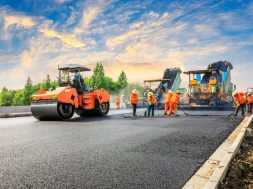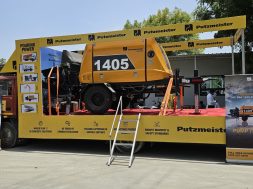EQUIPPING GROWTH [Nov 2011]
EQUIPPING GROWTH
"The Indian construction equipment industry has progressed over the years and is at present at an intermediate stage of development with growing investments and welcoming new entrants"
Positive trend emerging in the CE industryThe construction equipment industry in India has witnessed consistent significant double digit growth over the past few years. According to the industry estimates, the segment is poised for an unprecedented compounded annual growth rate of around 18 per cent during the next two years.
India’s infrastructure industry has the biggest potential for growth and opportunities for investment. The rise of the construction industry is coupled with a positive trend in equipment purchase with more players entering into the aggregate industry. According to Sunil Sapru, President, Liugong India, “Over the last 3 – 4 years various new entrants made inroads into the Indian construction equipment industry. With the emergence of new market players and expansion plans underway, the industry is expected to become more competitive and fragmented. However, these new capacities will find their home quite comfortably in the domestic market amid growing mechanisation and proposed large infrastructural projects”.
The market is huge and the competition is intense as only organised players operate in the market. Indian construction equipment market comprise of products from domestic as well as international players. In spite of the tough competition, new players are entering the market on a large scale. There is space for everyone in the huge Indian infrastructure segment as India offers the lowest price points in the world.
The CE Growth storyToday, India has been globally recognised as one of the fastest growing construction equipment market. The industry has registered a good growth in 2011. The growth has been 15 to 35 per cent on various product categories. Volumes for excavators, backhoe loaders and mobile cranes have grown substantially. The backhoe loader remains the largest selling equipment among all product categories. The only segment which has seen a negative growth is the road construction equipment, especially vibratory compactors, as progress on road projects remains sluggish. According to the industry estimate, the industry volumes stand at around 60,000 units. The growth prospects looks very well on a medium and long term perspectives. However, given the recent worrying trends in global economic conditions and the monetary regulation to contain a raging inflation within the country, in a short term perspective growth may slow down. Indian CE companies have to localise components and develop vendors to meet global quality standards, this will aid in offering cost-effective products to the customers.
According to Arun Savanur, VP and Head (CE division) of Greaves Cotton, “The total CE market in India has crossed 50,000 numbers milestone in 2010 and is projected to touch the landmark 1,00,000 in few years time. Earthmoving equipment will continue to hold a major share in this growth process followed by road making equipment, material handling equipment and concreting equipment etc.”
The major factors deciding the purchase of a CE is low owning and operating cost, technology and after-sales support. Infrastructure spending also plays a vital role in the overall GDP growth of the country. Currently construction segments contribute to almost 7.3 per cent in overall GDP. Thus the thrust of government on infrastructure spending will be a boon for the CE industry and the scenario is set for a long term and sustainable growth for the CE industry.
R Muralidhara Reddy, Director, Global Construction and Infrastructure Group, Caterpillar shares his views, “Among the infrastructure segment, roads play a significant role in the CE business, 7,300 km roads was planned this year, by end of Sep, 4500-4800 km will be awarded and 7730 km is to be awarded by December. All these highlight the opportunity for CE business in the infrastructure industry”. He further added,“For the general construction market in India, the backhoe loader dominates the machinery industry and is valued for its versatility and mobility. However, increasingly India is employing the concept of the right tool for the right job”.
For mining, Asia also represents opportunities to support long-term mining industry customers who are investing in their operations to support the growing demand for natural resources. This includes mature mining operations in South-East Asia and Australia as well as growing new mining operations in India where significant coal reserves and other deposits remain untapped. However, in the recent time, awarding of new mining projects is almost stopped due to irregularities observed in allocating of lands for mining. Some of the big ongoing mining projects are halted due to environmental clearances and local resistance. All of these have weakened the demand of mining equipment.
The Slowdown ImpactThe global economic slowdown had its moderate effects on the industry, but it regained growth momentum in FY 2010 and showed positive year-on-year growth. Commenting on the expected impacts of sluggishness in the US economy over Indian economy, Mr. Savanur said, “We are closely watching the current macro economic conditions like the global credit rating crisis and the rising interest rates due to high inflation pressure which can hinder the industry growth temporarily. But the silver lining is that the Indian CE market is primarily depending on domestic demand for which the government spending on infrastructure will be the key deciding factor.”
Highlighting the impacts of current slowdown over CE business, Mr. Sapru said, “The global financial slump has had its effect on the Indian construction equipment market. Global recovery is not yet assured and in most of the traditional equipment markets, prospects remain uncertain. In the large markets of US, Europe and Japan; growth is somewhat positive but recovery is tentative. India today accounts for a growing share of the global equipment market but penetration still remains low. However, this downturn has been a blessing in disguise as it taught us to be pragmatic.”
“The sluggishness in the US economy does not have a direct bearing on the situation but uncertainty in money market and high inflationary conditions in India are a great concern from a short term perspective as they restrict the growth momentum." However, in the medium and long perspectives, the prospects for infrastructure and construction sectors as well as construction equipment industry remain bright”, opined Rajesh Sharma, Vice President – Sales & Marketing, Escorts Construction Equipment.
Foreign Players DominateMost of the products available in the CE market today either have been brought in by the global companies directly or in partnership with the local companies, with little or inappropriate levels of customisation. If Indian companies remain happy selling equipment for which technology is not owned by them, then they will never be able to participate in the global market. They would not be allowed to do so by their global partners who are the owners of the technology. Elaborating the snags persist within the Indian CE manufacturers, Mr. Sharma commented, “If Indian companies do not stand on their own legs for developing technologies and products then we will surely miss the larger opportunity. There is no other way to leverage our advantage of being a low cost manufacturing country if we miss the export market. We have to start moving out of the shadows of the global companies and start building on our own technological competencies”.
However, there are a couple of external factors that would help the industry emerge successfully. In order to capitalise and sustain this demand, the government needs to take some pro-active steps in the form of rapid execution of planned projects. Further, issues relating to policies, land acquisition and funding have to be sorted out in order to maintain the growth trend.
The Indian companies in the CE and MHE industry have to work more towards developing technologies and equipment which are more suitable for the needs of the local market now and hone them to participate at global level later. “A very little work has happened in India in terms of building R&D capabilities. There are only a few companies which have done some real developmental work in terms of creating their own products”, recommends Mr. Sharma.
Cookie Consent
We use cookies to personalize your experience. By continuing to visit this website you agree to our Terms & Conditions, Privacy Policy and Cookie Policy.









